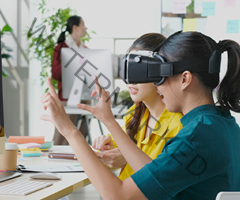
AR development involves overlaying digital content onto the real world, enhancing the user’s perception of reality. This technology is commonly used in mobile applications, gaming, marketing, education, and training.
VR development, on the other hand, creates a completely immersive digital environment that users can interact with using specialized headsets or devices. VR is widely used in gaming, simulation, training, and entertainment.
Developing AR and VR experiences requires a combination of hardware, software, and creative design skills. Developers use tools like Unity, Unreal Engine, ARKit, ARCore, and others to create compelling AR and VR applications.
When developing AR and VR applications, it’s essential to consider factors such as user experience, performance optimization, device compatibility, and content creation. Testing and iterating on the application are also crucial to ensure a seamless and engaging user experience.
Overall, AR and VR development offer exciting opportunities for creating innovative and immersive experiences that can transform industries and enhance user engagement. If you are looking to explore AR and VR development, consider partnering with experienced developers and designers who can bring your vision to life.
